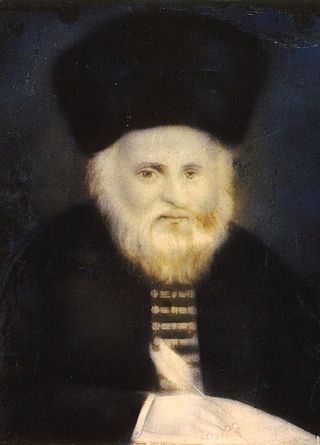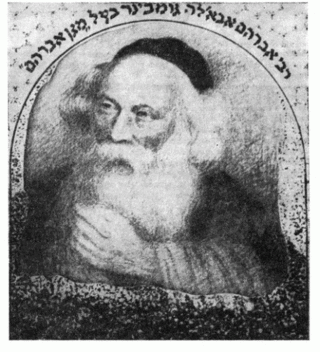
Moses ben Maimon (1138–1204), commonly known as Maimonides and also referred to by the Hebrew acronym Rambam, was a Sephardic rabbi and philosopher who became one of the most prolific and influential Torah scholars of the Middle Ages. In his time, he was also a preeminent astronomer and physician, serving as the personal physician of Saladin. He was born and lived in Córdoba within the Almoravid Empire, on Passover eve, 1138, until his family was expelled for refusing to convert to Islam. Later, he lived in Morocco and Egypt and worked as a rabbi, physician and philosopher.

The Mishnah or the Mishna is the first major written collection of the Jewish oral traditions that are known as the Oral Torah. It is also the first major work of rabbinic literature. The Mishnah was redacted by Judah ha-Nasi probably in Beit Shearim or Sepphoris between the ending of the second century and the beginning of the 3rd century CE in a time when, according to the Talmud, the persecution of Jews and the passage of time raised the possibility that the details of the oral traditions of the Pharisees from the Second Temple period would be forgotten.

Rabbinic literature, in its broadest sense, is the entire spectrum of rabbinic writings throughout Jewish history. However, the term often refers specifically to literature from the Talmudic era, as opposed to medieval and modern rabbinic writings, and thus corresponds with the Hebrew term Sifrut Chazal. This more specific sense of "Rabbinic literature"—referring to the Talmudim, Midrashim, and related writings, but hardly ever to later texts—is how the term is generally intended when used in contemporary academic writing. The terms mefareshim and parshanim (commentaries/commentators) almost always refer to later, post-Talmudic writers of rabbinic glosses on Biblical and Talmudic texts.

The Mishnah Berurah is a work of halakha by Rabbi Yisrael Meir Kagan. It is a commentary on Orach Chayim, the first section of the Shulchan Aruch which deals with laws of prayer, synagogue, Shabbat and holidays, summarizing the opinions of the Acharonim on that work.

Elijah ben Solomon Zalman,, also known as the Vilna Gaon (Yiddish: דער װילנער גאון Der Vilner Goen; Polish: Gaon z Wilna, Gaon Wileński; { or Elijah of Vilna, or by his Hebrew acronym Gra, was a Lithuanian Jewish Talmudist, halakhist, kabbalist, and the foremost leader of misnagdic Jewry of the past few centuries. He is commonly referred to in Hebrew as ha-Gaon mi-Vilna, "the genius from Vilnius".

The Soloveitchik dynasty of rabbinic scholars and their students originated the Brisker method of Talmudic study, which is embraced by their followers in the Brisk yeshivas. It is so called because of the Soloveitchiks' origin in the town of Brisk, or Brest-Litovsk, located in what is now Belarus. Many of the first Soloveitchik rabbis were the official rabbis of Brisk, and each in turn was known as "the Brisker Rov". Today, Brisk refers to several yeshivas in Israel and the United States founded by members of the Soloveitchik family, including: ‘Brisk Proper’(Now run by R’ Abraham Yehousua Soloveitchik),R’ Dovid’s, Tomo(Toras Moshe), and others.
Rosh yeshiva is the title given to the dean of a yeshiva, a Jewish educational institution that focuses on the study of traditional religious texts, primarily the Talmud and the Torah, and halakha.
In Jewish law and history, Acharonim are the leading rabbis and poskim living from roughly the 16th century to the present, and more specifically since the writing of the Shulchan Aruch in 1563 CE.
Rishonim were the leading rabbis and poskim who lived approximately during the 11th to 15th centuries, in the era before the writing of the Shulchan Aruch and following the Geonim. Rabbinic scholars subsequent to the Shulchan Aruch are generally known as acharonim.

A maggid, also spelled as magid, is a traditional Jewish religious itinerant preacher, skilled as a narrator of Torah and religious stories. A chaplain of the more scholarly sort is called a darshan. The title of maggid mesharim probably dates from the sixteenth century.
Arukh HaShulchan is a work of halacha written by Yechiel Michel Epstein (1829–1908). The work attempts to be a clear, organized summary of the sources for each chapter of the Shulchan Arukh and its commentaries, with special emphasis on the positions of the Jerusalem Talmud and Maimonides.

Aleksander is a Polish Hasidic dynasty originating from the city of Aleksandrow Lodzki, Poland, where it was founded by Grand Rabbi Yechiel Denciger (1828–1894). Aleksander is a branch of Vurka, as Shraga Fayvel Danciger was a leading disciple of Rabbi Israel Yitzhak Kalish of Vurka. Prior to the Holocaust, Aleksander was the second to largest Hasidic group in Poland. They attracted artisans, merchants and water carriers rather than elite Talmudic scholars and richer people who were attracted to Ger. Like the rest of Polish Jewry, almost all of Aleksander hasidim were murdered in the Holocaust. Between the world wars, Hasidic Jews from all over flocked to the small village of Aleksander to spend the holiest days of the Jewish year in the presence of their spiritual leader, their rebbe, Rabbi Yitzchak Menachem Danciger (1879–1942). The Rebbe of Aleksander attempted to remain neutral in political issues while emphasizing communal prayer and the study of Torah. He was murdered by the Germans on September 5, 1942, eight days before Rosh Hashana, at Treblinka extermination camp. Today, Aleksander has emerged from the ashes of the Holocaust and continues growing in numbers in small communities in America, Europe and Israel.

Abraham Abele Gombiner, known as the Magen Avraham, born in Gąbin (Gombin), Poland, was a rabbi, Talmudist and a leading religious authority in the Jewish community of Kalisz, Poland during the seventeenth century. His full name is Avraham Abele ben Chaim HaLevi from the town of Gombin. There are texts that list his family name as Kalisz after the city of his residence. After his parents were killed in 1655 during the aftermath of the Chmielnicki massacres of 1648, he moved to live and study with his relative in Leszno, Jacob Isaac Gombiner. From there he moved to Kalisz where he was appointed as Rosh Yeshiva and judge in the tribunal of Rabbi Israel Spira.
Joseph ibn Migash or Joseph ben Meir HaLevi ibn Migash or Yosef Ibn Meir Ha-Levi Ibn Megas or José ben Meir ibn Megas was a Rabbi, Posek, and Rosh Yeshiva in Lucena. He is also known as Ri Migash, the Hebrew acronym for "Rabbi Joseph Migash".
Maimon is a Jewish surname, and may refer to:

Sifrei Kodesh, commonly referred to as sefarim, or in its singular form, sefer, are books of Jewish religious literature and are viewed by religious Jews as sacred. These are generally works of Torah literature, i.e. Tanakh and all works that expound on it, including the Mishnah, Midrash, Talmud, and all works of halakha, Musar, Hasidism, Kabbalah, or machshavah. Historically, sifrei kodesh were generally written in Hebrew with some in Judeo-Aramaic or Arabic, although in recent years, thousands of titles in other languages, most notably English, were published. An alternative spelling for 'sefarim' is seforim.

Seirijai is a small town in Alytus County in southern Lithuania. In 2011 it had a population of 788.
Relative hour, sometimes called halachic hour, seasonal hour and variable hour, is a term used in rabbinic Jewish law that assigns 12 hours to each day and 12 hours to each night, all throughout the year. A relative hour has no fixed length in absolute time, but changes with the length of daylight each day - depending on summer, and in winter. Even so, in all seasons a day is always divided into 12 hours, and a night is always divided into 12 hours, which invariably makes for a longer hour or a shorter hour. At Mediterranean latitude, one hour can be about 45 minutes at the winter solstice, and 75 minutes at summer solstice. All of the hours mentioned by the Sages in either the Mishnah or Talmud, or in other rabbinic writings, refer strictly to relative hours.










